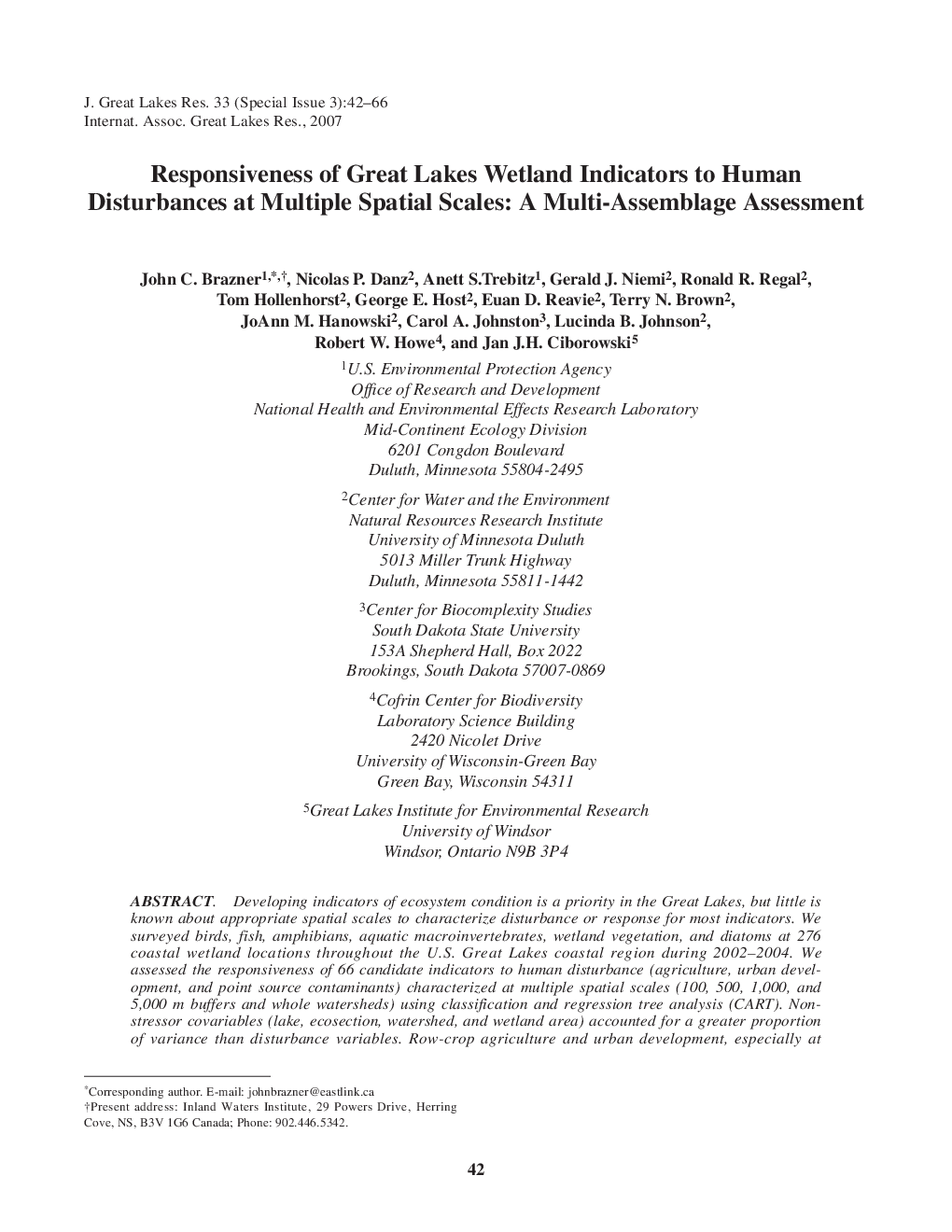| کد مقاله | کد نشریه | سال انتشار | مقاله انگلیسی | نسخه تمام متن |
|---|---|---|---|---|
| 4399448 | 1306746 | 2007 | 25 صفحه PDF | دانلود رایگان |
عنوان انگلیسی مقاله ISI
Responsiveness of Great Lakes Wetland Indicators to Human Disturbances at Multiple Spatial Scales: A Multi-Assemblage Assessment
دانلود مقاله + سفارش ترجمه
دانلود مقاله ISI انگلیسی
رایگان برای ایرانیان
کلمات کلیدی
موضوعات مرتبط
مهندسی و علوم پایه
علوم زمین و سیارات
علوم زمین و سیاره ای (عمومی)
پیش نمایش صفحه اول مقاله

چکیده انگلیسی
Developing indicators of ecosystem condition is a priority in the Great Lakes, but little is known about appropriate spatial scales to characterize disturbance or response for most indicators. We surveyed birds, fish, amphibians, aquatic macroinvertebrates, wetland vegetation, and diatoms at 276 coastal wetland locations throughout the U.S. Great Lakes coastal region during 2002-2004. We assessed the responsiveness of 66 candidate indicators to human disturbance (agriculture, urban development, and point source contaminants) characterized at multiple spatial scales (100, 500, 1,000, and 5,000 m buffers and whole watersheds) using classification and regression tree analysis (CART). Nonstressor covariables (lake, ecosection, watershed, and wetland area) accounted for a greater proportion of variance than disturbance variables. Row-crop agriculture and urban development, especially at larger spatial scales, were about equally influential and were more explanatory than a contaminant stress index (CSI). The CSI was an important predictor for diatom indicators only. Stephanodiscoid diatoms and nest-guarding fish were identified as two of the most promising indicators of row-crop agriculture, while Ambloplites rupestris (fish) and Aeshna (dragonflies) were two of the strongest indicators of urban development. Across all groups of taxa and spatial scales, fish indicators were most responsive to the combined influence of row-crop and urban development. Our results suggest it will be critical to account for the influence of potentially important non-stressor covariables before assessing the strength of indicator responses to disturbance. Moreover, identifying the appropriate scale to characterize disturbance will be necessary for many indicators, especially when urban development is the primary disturbance.
ناشر
Database: Elsevier - ScienceDirect (ساینس دایرکت)
Journal: Journal of Great Lakes Research - Volume 33, Supplement 3, 2007, Pages 42-66
Journal: Journal of Great Lakes Research - Volume 33, Supplement 3, 2007, Pages 42-66
نویسندگان
John C. Brazner, Nicolas P. Danz, Anett S. Trebitz, Gerald J. Niemi, Ronald R. Regal, Tom Hollenhorst, George E. Host, Euan D. Reavie, Terry N. Brown, JoAnn M. Hanowski, Carol A. Johnston, Lucinda B. Johnson, Robert W. Howe, Jan J.H. Ciborowski,